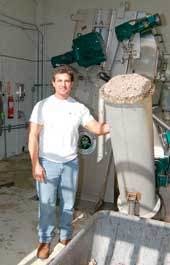The original steel bar screen at the City of Hammonton, NJ, rusted while continually allowing debris to pass through to the oxidation ditch and final clarifier. Floatables found their way through the plant to the UV trough, clogging the RAS and internal recycle pumps along the way. Managers of the Hammonton Wastewater Treatment Plant took on the challenge of finding a more efficient screening system. With the help of Mark Wolff of Watermark Environmental Services, a new Monster Separation System® was selected and installed.
The new system consists of a Finescreen Monster®, which features a continuous band of perforated stainless steel panels with 6mm openings that directs screened solids into an integrated Screenings Washer Monster®, a self-contained, hopper-fed system that grinds, washes, compacts, and dewaters discharged screenings. Both units, and their integrated operation, were designed and built by JWC Environmental in Costa Mesa, CA.
Anthony DeCicco, Superintendent of the facility, reports significant operational and maintenance benefits through replacement of the 12-year-old bar screen with the new, multi-faceted separation system. Incorporating the Screenings Washer Monster system into the plant eliminated the messy screw conveyor and dumpster while cleaning up the entire headworks.
“Our operation was experiencing clogging from floatables, hair and rags passing through the old bar screen,” said DeCicco. “We had been burdened for years by paper, plastic and latex materials, especially grease from saturated fats. Since the installation of the new system in September 2006, more solids are being captured and we have had little to no maintenance.”
Originally built in 1994, Hammonton WWTP had been operating with the original equipment. With over 4,000 domestic connections, growth in Hammonton, touted as the ‘Blueberry Capital of the World’, has been steady, including growth in blueberry farming and in the restaurant business, which created a noticeable increase in the amount of cooking oil and grease going into the sewage system.
The city has JWC Muffin Monster® grinders installed at all seven of its pump stations, so was familiar with the company’s products.
“Hammonton has a smart strategy for handling inorganic solids,” said Alec Mackie, JWC’s Marketing Manager. “They don’t screen at their pump stations, instead they grind solids and send them to the plant where the Finescreen Monster takes them out. It’s so much easier to empty one trash bin rather than eight of them.”
The facility, which averages 1 mgd and can handle a peak flow of 7 mgd, serves a population of over 12,000, and a large number of high grease-producing restaurants. The fat, oil and grease (FOG) arrives at the WWTP in partially solidified globs, which passed through the old bar screens and clogged the pumps. The grease ‘balls’ are now removed from the flow and put through the process of the Monster Separation System.
The MSS installation eliminated several trouble spots for DeCicco and his crew. Prior to its installation, a manual screen were installed at the end of the process to compensate for the old screen’s low capture rate. Grease, rubber and hair had been significant culprits in clogs and manual cleaning. Now, these have been eliminated and DeCicco and his crew are free to address other functions at their facility.
The system is designed to provide screenings ready for disposal. Removed solids typically contain up to 50% dry solids; are reduced in volume by 80% or more; and are significantly lighter than typical screened solids.
In the Finescreen Monster part of the system, wastewater in the channel flows to a screening zone - a continuous band of perforated panels with 6-mm openings. During the operation cycle, a drive moves the panels from the screening zone to a cleaning mechanism at the discharge point. Debris is removed from the panels by a 2-stage brush/wash water system, and screenings are then conveyed for further processing in the second part of the system.
In the Screenings Washer Monster part of the system, solids are removed from the Finescreen, flushed through a grinder for size reduction, and are washed and conveyed by an auger. Soft organics and the wash water are passed through the auger’s perforated trough and are returned to the plant’s waste stream. The captured solids are compacted, dewatered, and discharged as a cake into a receptacle for disposal.
For further information, contact JWC Environmental, 290 Paularino Ave., Costa Mesa, CA 92626, USA, Tel. (800) 331-2277, Fax (949) 833-8858, www.jwce.com, [email protected].




